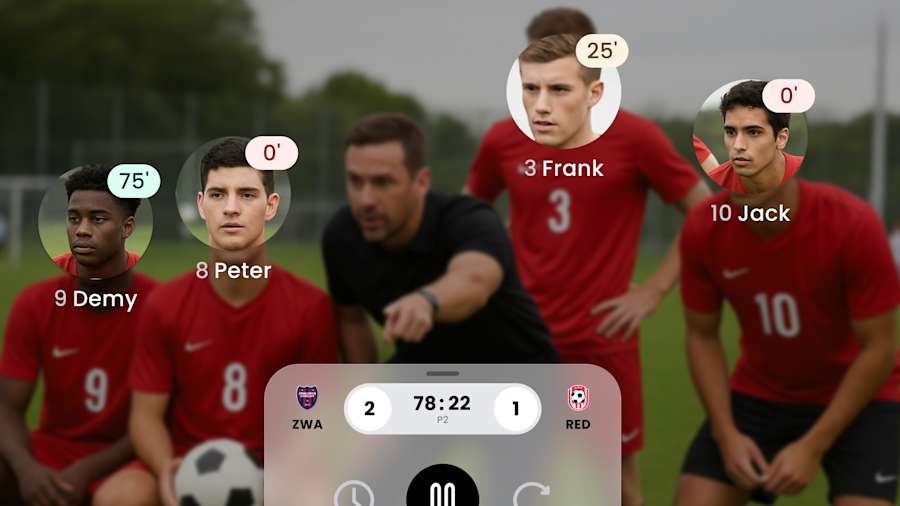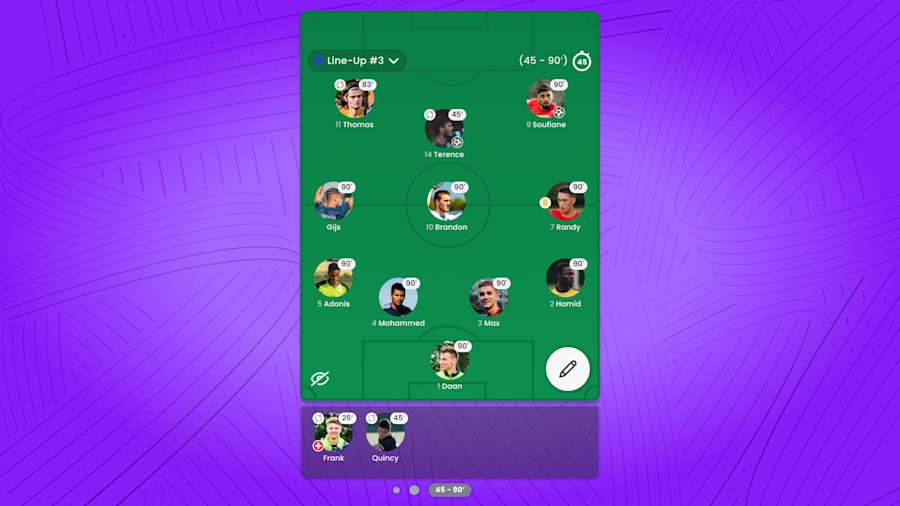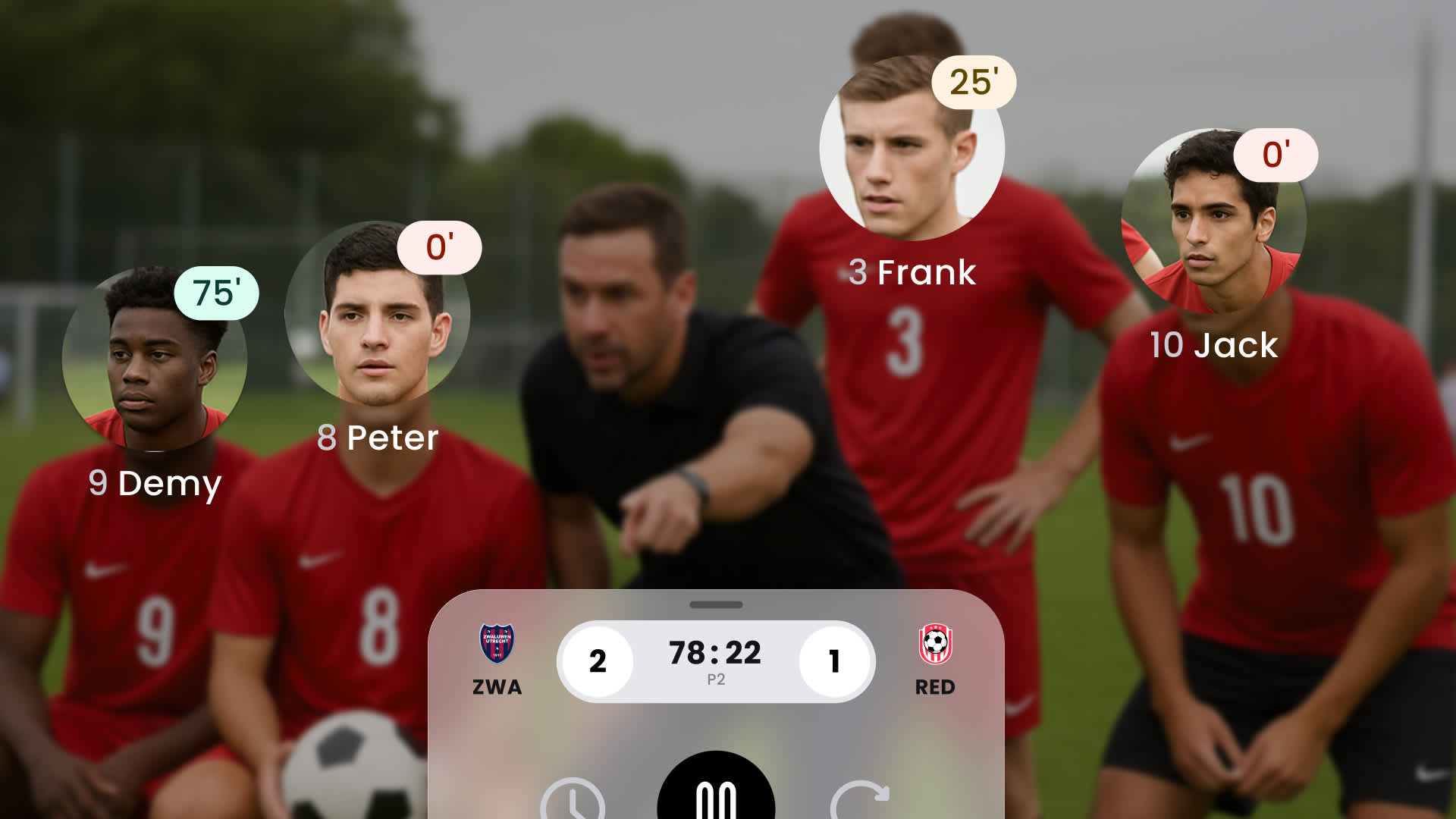Ultimate Guide for Choosing a Playing Time System for your football team

Coaches and clubs lack a clear, measurable playing-time system — leading to inconsistent minutes, frustrated stakeholders, slower player development and fragile team culture.
We spend a lot of time researching Playing Time. Spoke to many coaches. And decided to write the ultimate guide about playing time.
It provides a summary of scientific research on the subject of Playing Time distribution and how it affects player development, motivation and team performance. The core of this guide is centred around the different systems a coach or club have at their disposal to distribute playing time. A playing time system that fits the team or club values and purpose.
What is the problem with Playing Time?
Playing time is often inconsistently managed across teams and clubs, undermining development, retention and trust.
Many coaches and club managers lack a clear, documented playing-time philosophy and haven’t evaluated alternative allocation models (equal, minimum-threshold, merit-based, hybrid). As a result decisions are made ad-hoc (game-to-game or emotion-driven), with little season-level tracking or transparent communication. That combination produces predictable negative outcomes: frustrated players and parents, stalled player development, avoidable performance problems at team level, and loss of trust in the club’s pathway.
What Scientific Research Says About Playing Time
Playing time allocation is both a developmental and a fairness issue. Tormod Lorentzen (2016) frames playing time as a dilemma between promoting player development (egalitarian/mastery approach) and rewarding performance (merit-based approach). His conceptual model, supported by a simple mathematical framework, shows that structural constraints such as roster size, match length, and substitution rules limit the extent to which coaches can equalize playing time. This research provides a foundation for deliberately choosing and defending a playing time policy. Lorentzen (2016)
Early participation and broad opportunities are key for long-term development. The Developmental Model of Sport Participation (DMSP) emphasizes the benefits of diversified play during early years, showing that children who receive more equitable playing time develop a wider range of skills, maintain motivation, and are less likely to drop out. Côté and Hay (2002) and Côté, Baker, & Abernethy (2007) highlight that exposure to game situations and meaningful minutes in youth sport fosters long-term engagement and skill growth. DMSP overview | Practice vs Play chapter
Playing time affects motivation, enjoyment, and retention. Empirical research shows that children’s perception of fairness and their experience on the field significantly influence enjoyment and sustained participation. Visek et al. (2015) identify playing time as one of the key contributors to “fun,” which drives retention, while Fraser-Thomas, Côté, & Deakin (2008) show that limited or unequal minutes correlate with increased dropout risk. Fun Integration Theory | Dropout study
Perceived fairness matters for engagement and team climate. Broader behavioural science research demonstrates that inequity or unfairness provokes strong emotional responses. Fehr & Schmidt (1999) show that even small inequalities in allocation can lead to dissatisfaction and conflict. Applied to sport, this underlines why transparent policies and clear communication about playing time help maintain trust and motivation. Fehr & Schmidt, 1999
Policy guidance translates evidence into practice. Reports like the Aspen Institute’s Project Play (2019) recommend age-appropriate policies: near-equal minutes for younger age groups, hybrid models for adolescents, and performance-based criteria for older competitive athletes. These guidelines synthesize developmental, psychological, and fairness research into actionable recommendations for coaches. Project Play: State of Play 2019
What are indicators of poor playing time management?
Maybe your team is doing fine. At the surface. You win more matches than you lose. Players seem happy. But do players get equal development opportunity? Are there a few players dropping out next season because their motivation is low?
Chances are high that you are managing playing time ineffectively when you observe the following:
Repeated parent/ player complaints about minutes. Players with low cumulative minutes across the season (e.g., <50% of available minutes).
Player development markers plateauing (fitness, decision-making, skill metrics tracked in practice).
Team performance dips tied to irregular lineups / poor cohesion in late game phases.
No centralized minutes-tracking spreadsheet or dashboard covering season totals and per-game distributions.
Why is it so hard to manage playing time ‘the right way’?
From an outside perspective it is easy to point at weak playing time management. But once you’re a coach or club manager responsible for playing time policies, it becomes clear that managing playing time ‘the right way’ can be complex and hard.
Managing and tracking Playing Time is hard
Tracking time every match is hard and often requires a lot of manual work. Especially when you have a substantial bench of 4 or more players, do continuous rotations and you need to actively coach the team, it becomes a balancing act. For the U9-U14 age groups this often requires a dedicated assistant with a stopwatch, line-up board and ‘child management’ skills.
Juggling conflicts of interests
You want to maximise player development and you want to win. You want to reward training attendance, but need to cover some field positions with few alternatives. You might have some vocal parents on your back. The reason why coaches or clubs are not articulate about their playing time policy is not because they don’t want to, but because they rather deal with the complexity ‘internally’.
Lack of time and knowledge
Managing Playing Time ‘the right way’ can be time intensive when you do it manually, but most importantly it’s good to know that you’re dealing with a really complex problem. There is social complexity: you’re dealing with motivation of young people. You’re dealing with parents emotions. There is operational complexity with substitution management, playing time tracking. And finally, there is mathematical complexity both at a match level as a seasonal level. Especially when you want to implement a hybrid playing time model that combines an equal playing time floor (everyone gets to play at least 60% of the time) with a with some sort of differentiating model (eg rewarding training attendance and giving more time to impactful players).
How to manage Playing Time ‘the right way’
As with many things in life: there is no single ‘right way’. But some solutions are better than others.
Let’s agree that ‘the right way’ of managing Playing Time is the way that fits your team purpose best.
Team Purpose
Every coach wants to balance inclusion, development and team performance. But what is most important for your team?
1. Participation & Inclusion (FUN) Your primary goal is to give every player the chance to play and enjoy the sport. Winning is nice, but not at the expense of (youth) players sitting on the bench. Parents paid the same fee, so all kids deserve to play. Most players won't continue beyond this level, so the focus is on fun, basic skills, and falling in love with the game. Typical contexts: Recreational leagues, community programs, grassroots clubs, U6-U12 house leagues.
2. Player Development (LEARNING) Your primary goal is maximizing each player's long-term potential, even if it means sacrificing short-term results. You're willing to play a less experienced player in a key moment because they need that challenge to grow. You understand that "the player ranked 4th at age 12 might be your best by 15" Should We Give Kids Equal Playing Time in Youth Soccer?and make decisions accordingly. Typical contexts: Academy programs, club development teams, elite youth programs focused on producing future high-level players.
3. Competitive Performance (WINNING) Your primary goal is winning games while still developing players. Results matter—to you, to parents, to the club. You want to develop all players, but when it's a close game in the final minutes, you're putting your best players on the field. You balance development with the reality that competitive success creates opportunities (tournaments, showcases, college recruitment). Typical contexts: Travel/select teams, high school varsity, top-tier competitive clubs, tournament teams.
Playing Time policy decisions
Once you have a clear understanding of your team’s ‘Why’, you can outline a specific Playing Time Policy and choose a specific Playing Time System.
A Playing Time System is a set of guiding principles and rules that determine how playing time is allocated across a season and individual matches, aligned with the Team Purpose.
There are more than 10 different Playing Time Systems to choose from. It takes quite some time to fully understand their differences and implications.
Let’s start with the 2 systems on the extreme ends of the Playing Time distribution spectrum:
Equal Playing Time: every player gets exactly the same playing time
Performance Based Distribution (Meritocracy): the best players get to play the most at the cost of weaker players.
Scientific research is very clear about Equal Playing Time distribution being the preferred strategy for teams at younger age groups (U7 - U13). In some countries federations have put specific policies in place to ensure Equal Playing Time is implemented in every team at younger age groups.*
| Region | Equal Playing Time (U6-U12) | Enforced Nationally? |
|---|---|---|
Scandinavia | Required by national federations | Yes |
Australia (MiniRoos) | Required nationally | Yes |
England | Recommended strongly | No |
Benelux | Standard practice & encouraged | Not strictly enforced |
Hybrid Playing Time Systems
Most real-world Playing Time approaches sit on a spectrum between Equal Playing Time and Pure Meritocracy. They often have a guaranteed ‘floor’ (eg every player gets at least 50-60% of playing time) plus a distribution mechanism for the remaining playing time.
The first question to ask yourself when choosing a Hybrid Model: do we have a guaranteed floor? And how much is it?
Once you have answered that, you can decide on the distribution mechanism for the flexible part. Which System you choose depends on factors players can control (Player Factors) and the Context of a Match (Match Context).
Player Factors
Training Attendance: player with higher (training) attendance get more playing time.
Match Performance: to what extent can the player influence the game outcome with their current ability and tactical understanding?
Development Potential: what is the player's development goal and is this match and opponent a good fit for this player to work on their development goals?
Match Readiness (stamina): is the player physically fit and healthy enough to play? Includes injury status, fatigue level, and physical conditioning.
Attitude: how would you rate this player's overall attitude on and off the pitch, response to coaching, and impact on the team?
How to measure Player Factors
In order to avoid ambiguity and administrative load it’s crucial to measure player factors in a simple and understandable way.
| Factor | How to measure | Comments |
|---|---|---|
Training Attendance | Attendance Tracking | Be clear about valid reasons of absence |
Match Performance | Scale (1-10), MPR or 3 tier: Impact, Role or Emerging | Make sure to update regularly or do a match by match evaluation |
Development Potential | High potential match, medium potential match, low potential match. | Would more playing time significantly accelerate this player's development? |
Match Readiness (Stamina) | Scale (1-10) or Stamina Test | Scale (1-10) can be through self assessment or coach assessment |
Attitude | Negative, neutral, positive | Update weekly. E.g. too late at the training can become |
Guiding Principles when including Player Factors in Playing Time Distribution
There is a tradeoff coaches should be aware about when including Player Factors in allocation of playing time. You’re overal model might win in fairness but lose in clarity. You might over-engineer a system that is beautiful in a spreadsheet but no one understands.
Here are some guiding principles when including Player Factors into Playing Time distribution:
Communicate clearly which factors you include and how (eg missing a training means you will get max 60% of the playing time for a match)
Start with Simple rules before sophisticated ones (eg players who complete the Stamina Test under level 14.2 will not play more that 60% of a match)
Do not include Player Factors without Player Development Check-Ins every 4-6 weeks. It should be clear for players where they stand and how they can improve. This requires 1 on 1 conversations between a coach and a player.
Avoid adding too many factors from the get to. When implementing a system start with 1 or 2 factors. You can always make the system more sophisticated.
Match Context: not every match is the same
A smart way to balance development with competitiveness is to distinguish between ‘Key Matches’ where winning is the primary goal and Development Matches where learning is most important.
We propose a simple 3 category classification.
| Match Type | Approach | Typical matches |
|---|---|---|
DEVELOPMENT MATCH | Maximize learning opportunities for all players with Expanded rotation, equal or near-equal time. Player factors matter less; focus on giving experience | • Early season league games • Pre-season friendlies • Mid-week cup matches (non-elimination) • Games against significantly weaker opponents |
STANDARD MATCH | Balance development with competitive performance with normal rotation based on your team's policy for dividing playing time. | • Regular league games • Most competitive fixtures • Standard tournament pool play |
KEY MATCH | Winning is paramount with Best lineup, merit-based, "win week" approach. Performance Impact factor weighted heavily; still respect minimums. | • Championship/playoff games, tournament finals, "must-win" situations • Derby/rivalry matches • Showcase tournaments for college recruitment • League title deciders |
Playing Time System Overview
Choose a system that aligns with your Team Purpose and can incorporate your chosen Player Factors and Match Context differentiation.
Base Systems

| System | Description | Best Team Purpose Match | Player Factors Integration | Risks / Downsides | How to Mitigate |
|---|---|---|---|---|---|
Equal Playing Time | Every player receives identical playing time each game, regardless of ability or effort. | FUN (Participation & Inclusion) - U6-U12 recreational; participation-focused programs | None - system ignores player factors | Limits competitiveness; top players may feel underused; less tactical flexibility. | Reserve for youngest age bands; communicate developmental rationale; transition gradually; can layer Match Context (equal in league, slightly flexible in friendlies). |
Commitment-based System | Everyone guaranteed substantial base (50-60%); remaining minutes distributed by player factors. | FUN → LEARNING transition (U10-U16 balanced programs) | Low integration: Typically 1-2 factors (Attendance and/or effort) with simple rules | Criteria can seem arbitrary if unclear; requires tracking; parent questions about fairness. | Define transparent bonus criteria; track consistently; communicate formula at season start; limit to 1-2 factors initially. |
Development-Focused System | Each player gets a guaranteed base per month; remaining minutes distributed by development goals, attendance, attitude, match readiness and match performance. | LEARNING (targeted interventions) - Teams with large ability gaps; pre-season/friendlies | Medium integration: Development Need primary factor (inverted); Performance Impact secondary | Strong players may disengage; significantly affects results; hard to explain to competitive parents. | Use selectively (friendlies, 4-week experiments); provide extra challenge for top players; set clear time boundaries; explain rationale using research. |
Competitive Development System | Best performers earn most minutes; everyone guaranteed meaningful minimum (30-50%). | WINNING (Competitive Performance) - U13+ competitive teams balancing results with retention | High integration: All 5 factors can be used; Performance Impact weighted 40-50% | Perceived bias in defining "best"; fringe players may plateau; risk of early specialization bias. | Communicate minimums pre-season; monthly player reviews; use objective performance criteria; provide development plans for lower-minute players. |
Performance First System | Playing time determined solely by current performance; minimal or no guaranteed minutes. | WINNING (Elite/Senior) - U16+ elite; senior first teams; playoffs only | Minimal integration: Performance Impact only (100% weight); other factors irrelevant | High dropout risk; perceived inequity; burnout; kills team culture if misapplied at wrong age. | Use ONLY in appropriate contexts (age 16+, elite level); communicate selection standards; ensure competitive alternatives exist; NOT for youth development contexts. |
Match context as a modifier
💡Any base system above can incorporate Match Context differentiation (Development / Standard / Key matches). But, Match Context differentiation adds complexity. Start simple (single base system) before layering context rules.
How to apply:
Choose your base system (e.g., "Performance-Based with Protections")
Layer Match Context rules (e.g., "Development matches: expand floor to 60%; Key matches: reduce floor to 30%")
Pre-classify your season matches (example: 60% Standard, 30% Development, 10% Key)
Context-aware variations:
Context-Based Development: use different base systems per match type (e.g., Equal in Development matches, Merit Bonus in Standard, Performance-Based in Key)
Context-Based Competitive: primarily performance-driven but adjusts criteria by opponent quality, score differential, tournament vs. league
Implementing a Playing Time System
Before you make a final decision about which Playing Time System to use, you should consider how much time and effort you want to invest in implementation. A sophisticated system might come with new approaches to they way you track and manage playing time during a match and over the course of a full season.
Implementation Methods
The implementation methods describe How you decide and distribute playing time. You can only have ONE fundamental approach to distributing playing time at a time
| Method | What It Does | Works With | Complexity |
|---|---|---|---|
Points-Based System | Assigns numerical points for Player Factors; points determine minutes or tier placement via formula | Any hybrid system with Player Factors | High - requires point calculation system |
Fixed Rotation Schedules | Pre-planned substitution patterns (quarter/half-based) determined before match | Pure Equal, Equal Base + Merit | Low - simple once pattern established |
Season-Balance Method | Tracks cumulative minutes across season; future allocation adjusts to hit target percentages | Any system with guaranteed floors | Medium - requires season-long tracking |
Dynamic In-Game Adjustment | Coach makes real-time decisions during match based on game flow, score, performance | Performance-based systems, Context-aware systems | High - requires experienced judgment |
Tracking and Management Tools
There are multiple tools that help you monitor and execute your method. You can use multiple tools at the samen time.
| Tool Type | What It Does | When You Need It | Examples |
|---|---|---|---|
Live/Real-Time Tracking | Monitors current playing time during match; provides alerts for substitutions | Essential for: Equal systems, guaranteed minimums; Helpful for: All systems | SubTime, Mingle Sport, GameChanger, stopwatch apps, assistant with timer |
Season Tracking Spreadsheet | Records cumulative minutes across all matches; calculates percentages and trends | Essential for: Season-balance methods, systems with floors; Helpful for: Transparency, parent communication | Excel/Sheets templates, team management platforms |
Substitution Planning Tools | Pre-game tools to plan rotation patterns and lineups | Helpful for: Fixed rotations, large rosters, less experienced coaches | Rotation calculators, lineup cards, apps with planning features |
Points Calculation Systems | Tracks and calculates points from Player Factors | Essential for: Points-based systems | Custom spreadsheets, team management software with scoring |
Conclusion
Managing playing time effectively is not about finding the perfect system—it's about choosing a deliberate, transparent approach that aligns with your team's purpose and then implementing it consistently. The research is clear: ad-hoc, reactive playing-time decisions undermine player development, erode trust, and create unnecessary friction with players and parents. Yet with the right framework, this challenge becomes manageable.

Your next steps are straightforward:
Define your Team Purpose (Fun, Learning, or Winning) and communicate it clearly to all stakeholders
Select a Playing Time System that matches your purpose and context—starting simple is better than over-engineering
Choose your Player Factors (if any) and commit to transparent, consistent measurement
Implement tracking tools that make execution feasible without overwhelming your coaching workload
Communicate your policy at the season start, and hold regular check-ins with players about their development
The difference between teams that struggle with playing-time conflict and those that build trust through fairness is rarely talent—it's clarity, consistency, and communication.
Ready to build your policy? Use our Step-by-Step Playing Time Policy Builder to walk through each decision point, compare systems side-by-side, and generate a customized policy document you can share with your team. The tool includes templates for parent communication, season tracking spreadsheets, and substitution planning guides—everything you need to move from theory to practice.
Don't let another season pass with playing-time decisions made in the moment. Take 20 minutes to define your approach now, and spend the rest of the year coaching with confidence and clarity.
References
https://playerdevelopmentproject.com/qa-should-i-give-my-players-equal-playing-time/
https://www.dutchfc.com/playing-time-in-club-soccer
Lorentzen, T. (2016). Playing-time allocation in team sports and the egalitarian dilemma. Sport, Ethics and Philosophy, 10(4), 364–377. https://doi.org/10.1080/23265507.2016.1266694
Côté, J., Baker, J., & Abernethy, B. (2007). Practice and play in the development of sport expertise. In G. Tenenbaum & R. Eklund (Eds.), Handbook of sport psychology (3rd ed., pp. 184–202). Hoboken, NJ: Wiley. https://doi.org/10.1002/9781118270011.ch8
Côté, J., & Hay, J. (2002). Children’s involvement in sport: A developmental perspective. In J. M. Silva & D. E. Stevens (Eds.), Psychological foundations of sport (pp. 484–502). Boston, MA: Allyn & Bacon.
Visek, A. J., Mannix, H. M., Chandran, A., McDonnell, K., & DiPietro, L. (2015). The Fun Integration Theory: Toward sustaining children and adolescents sport participation. Journal of Physical Activity and Health, 12(3), 424–433. https://doi.org/10.1123/jpah.2013-0180
Fraser-Thomas, J., Côté, J., & Deakin, J. (2008). Understanding dropout and prolonged engagement in adolescent competitive sport. Psychology of Sport and Exercise, 9(5), 645–662. https://doi.org/10.1016/j.psychsport.2007.08.003
Aspen Institute (2019). Project Play: State of Play 2019 – Trends and Developments. Washington, DC. https://www.aspenprojectplay.org/state-of-play-2019
Fehr, E., & Schmidt, K. M. (1999). A theory of fairness, competition, and cooperation. Quarterly Journal of Economics, 114(3), 817–868. https://doi.org/10.1162/003355399556151




